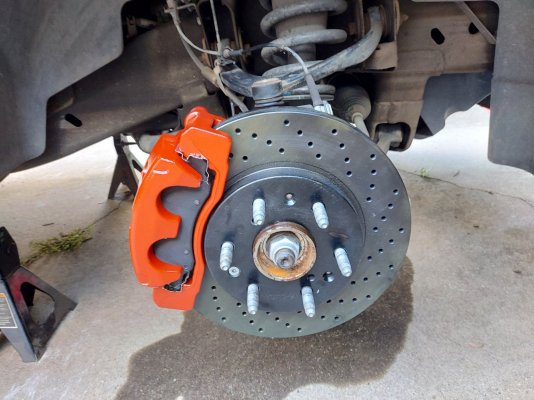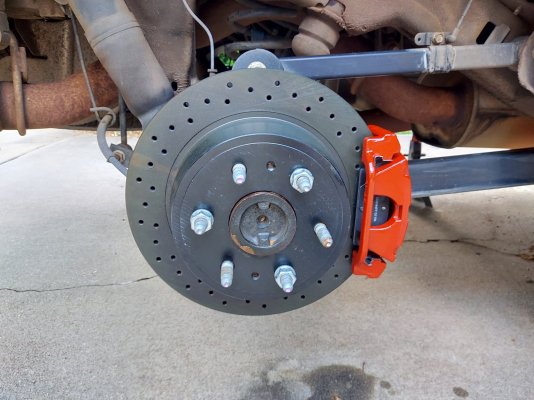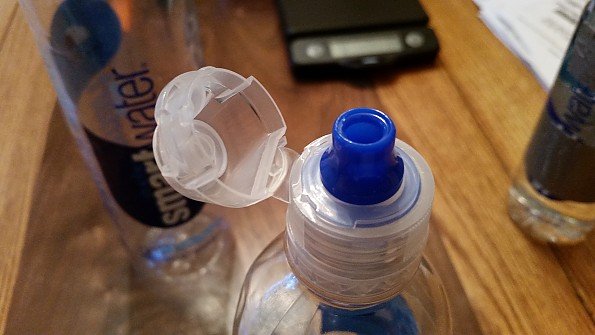I use the classic method with a bottle and tubing and working the pedal, but I do it alone. Two people is unnecessary and complicates it.
I use a 1-liter smartwater bottle that has the flip-cap and spout:
View attachment 371574
I use a length of mechanic's wire wrapped tightly around the neck to hang it near the caliper. The clear tubing I got from Home Depot (or Lowe's?) fits firmly through the spout. I heated the other end of the tubing to soften it and pushed it over the bleeder screw to flare and form it so that it'd be easier to slip it onto the bleeder. Put the tube to the bottom of the bottle and add some fluid so that the end is submerged. Set up at the right rear corner. It might take a few tries, but you want the bleeder just loose enough to provide a bit of resistance when pushing the pedal. Not so firm that you have to put a lot of effort to stroke the pedal but no soft that it flows so freely. I'd say you want about the normal amount of sponginess that you're trying to get rid of. There's no need for the "pump, pump, hold" stuff. When you stroke the pedal, you want to remain within the normal range of stroke. Don't floor it or you might be needing a new master cylinder. Use a brick, 2x4 or your other foot to create a stop to prevent going too far. Stroke it slowly- no need to rush because this can cavitate the fluid. After 2-3 strokes like this, just as you start to make the 4th stroke, turn the key to "ON", right before the "START" position. The ABS solenoids are activated during the self-check. With a little pressure on the system (you pressing on the pedal), fluid is pushed towards that rear corner, carrying the air out of the ABS module. Leave the key on for 1-2 strokes, turn the key off for 2-3 more strokes, then repeat with the key on, etc. Do this until you have fresh fluid at that corner. You can go check the bottle and pour it out if it's getting full and you wanna pump more, but you shouldn't have to. Be sure to tighten the bleed screw before you move the bottle to dump it. No need to torque the bleeder down, just snug it for this step in case you wanna bleed it some more. You can leave the hose on the nipple with fluid in it to act as an air lock. Keep an eye on the reservoir. DO NOT let it run empty. If you'd feel more comfortable, have a helper monitor the bottle and reservoir. The first time I did this, I used my work phone to FaceTime my personal phone. I set up the work phone to watch the bottle so I could watch the color of the fluid change and for any air bubbles in the hose while I worked the pedal and key. Then I realized that there's not some huge amount of volume flowing through there and the bottle isn't gonna suddenly fill up and/or reservoir drain dry. So, watching it that closely was unnecessary. After you've pumped a good bit of new, clean fluid with no bubbles, tighten the bleeder and repeat for the next farthest corner- the left rear. There shouldn't be nearly as much old fluid in that one. Repeat for the right front and, finally, the front left.
Yes, you will go through a couple quarts of new fluid. But, you'll have replaced virtually every molecule of old fluid while bleeding the ABS module by yourself and with no special equipment. This process might sound like it'll take all afternoon. It actually only takes about 30 minutes. It's the standard driveway bleeding process, just with turning the key on at specific times to bleed the ABS module added in.
I'm not against using special equipment that would be easier and probably faster. I just don't bleed brakes often enough to make it worth me investing in anything like that. Taking 30 minutes to bleed brakes versus 15 every few years isn't gonna alter my life at all.




